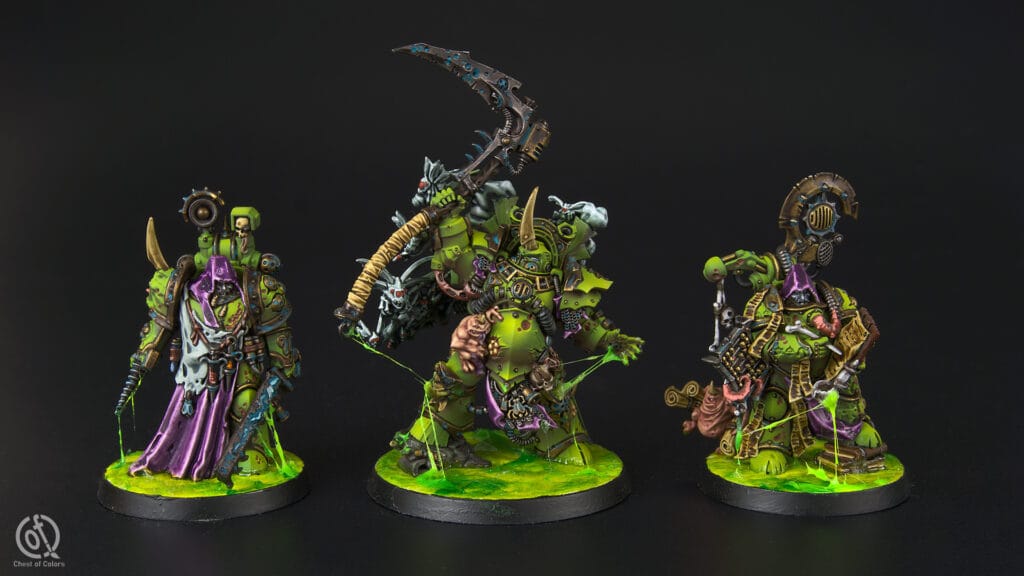The Death Guard is a Chaos Space Marine Legion that has turned its allegiance to the Chaos God Nurgle. Their decayed and grotesque appearance is the signature feature of the Death Guard. This legion, once loyal to the Emperor of Mankind, sows now feared across the galaxy for their resilience and tenacity.
Some time ago, Vaeroun completed an impressive commissioned project: painting a Death Guard army. The customer’s request was to make the army bright and eyecatching, despite going only with gaming-quality painting. Although Vaeroun’s less active these days, we would like to cast some light on one of his more recognizable projects. So in this post, we delve into his work on this formidable army.
Painting a Death Guard Army For Gaming
Vaeroun took on the ambitious task of painting a complete Death Guard army for Warhammer 40,000. This army features iconic units such as Mortarion, the Great Unclean One, Plague Marines, Pox Walkers, Fetid Bloat Drones, Plagueburst Crawlers, Blightlords, Typhus, Scribbus Wretch, and Nauseous Rotbone. The bright, sickly colors used here, combined with enough detailing for high gaming quality standard, created a cohesive force that both intimidates and impresses.

Style and Techniques
Vaeroun’s approach to painting the Death Guard emphasizes their diseased nature. He used a combination of weathering techniques, washes, and airbrushing to achieve a sickly, toxic appearance. It was the customer’s request to make the army bright and eyecatching on the tabletop, so Vaeroun followed this suggestion. The use of various shades of green helped create the daunting, corrupted look that makes Death Guard armies easily recognizable.
Vaeroun used true metallics for this project because they look great on gaming miniatures. Especially with the weathering, so typical for Death Guard armies.
Key Units of the Army
- Mortarion: The towering Primarch of the Death Guard, Mortarion is holding with his signature scythe and. You can easily recognize him thank to his formidable presence. Vaeroun made him the natural centerpiece of the army.

- Great Unclean One: Vaeroun painted this grotesque daemon of Nurgle to highlight its bloated and diseased form. Vaeroun’s application of bright, toxic colors brings out the sickening details, making it a true representation of Nurgle’s corruption.
- Plague Marines: These elite Chaos Space Marines have multiple mutations and are immune to disease. The painting emphasises their resilience and accentuates the intricate details and mutations on each model.

- Pox Walkers: As mindless zombies that serve Nurgle, these miniatures are painted with a dirty, rotten appearance. Vaeroun’s went for fast-painting techniques to create a horde or horrifying servants.
- Fetid Bloat Drones and Plagueburst Crawlers: These daemon engines and armored vehicles are painted to emphasize their role in spreading disease and decay. The weathering, chipped paint and rust effects applied by Vaeroun give them a battle-worn, corrupted look.

- Blightlords: Clad in Terminator armor, these elite troops are equipped with deadly weapons. Vaeroun made sure they would look proud among other units, emphasizing their menacing presence even more.
- Typhus and Support Characters: Typhus, along with Scribbus Wretch and Nauseous Rotbone, are painted to highlight their roles within the Death Guard. Vaeroun’s attention to their unique characteristics, from Typhus’ massive scythe to Scribbus Wretch’s meticulous tools, brings each character to life.

- Chaos Spawns: Those Creatures are the results of receiving too many mutations as either blessings or curses from their gods, turning them into mindless but dangerous monsters.
The Painted Army
The final result is nothing short of spectacular. Vaeroun’s painted Death Guard army is not only a formidable force on the battlefield but also a sight to behold. Each miniature, from the imposing Mortarion to the lowliest Pox Walker, is a piece in the big picture that the army became thanks to Vaeroun’s skill and dedication to the craft.























How Do You Like It?
We’re thrilled to showcase Vaeroun’s impressive work on this Death Guard army. His decidation, knowledge of various painting techniques and attention to detail have resulted in a truly breathtaking force. If you’re inspired by this project and would like to have your own miniatures professionally painted, check out our miniature painting service for more information.
Join the Conversation
What do you think of Vaeroun’s take on painting Death Guard? Have you tried painting your own Death Guard miniatures? Share your thoughts and experiences in the comments below!




![Frodo and Sam, Breaking of the Fellowship diorama [Games Workshop]](https://i2.wp.com/chestofcolors.com/wp-content/uploads/2024/06/fellowship-IMG_5225-1024x1024.jpg?ssl=1)
![Faces of the Breaking of the Fellowship diorama [Games Workshop]](https://i1.wp.com/chestofcolors.com/wp-content/uploads/2024/06/20230308-fellowship-faces-151205-1024x1024.jpg?ssl=1)
![Detail closeups of the Breaking of the Fellowship diorama [Games Workshop]](https://i1.wp.com/chestofcolors.com/wp-content/uploads/2024/06/20230308-fellowship-details-151729-1024x1024.jpg?ssl=1)
![Merry and Pippin, Breaking of the Fellowship diorama [Games Workshop]](https://i1.wp.com/chestofcolors.com/wp-content/uploads/2024/06/fellowship-IMG_5218-1024x1024.jpg?ssl=1)
![Aragorn, Breaking of the Fellowship diorama [Games Workshop]](https://i1.wp.com/chestofcolors.com/wp-content/uploads/2024/06/20230307-fellowship-aragorn-172237-1024x1024.jpg?ssl=1)
![Boromir, Breaking of the Fellowship diorama [Games Workshop]](https://i0.wp.com/chestofcolors.com/wp-content/uploads/2024/06/fellowship-boromir-IMG_5223-1024x1024.jpg?ssl=1)
![Sam, Breaking of the Fellowship diorama [Games Workshop]](https://i0.wp.com/chestofcolors.com/wp-content/uploads/2024/06/20230307-fellowship-sam-172321-1024x1024.jpg?ssl=1)
![Frodo, Breaking of the Fellowship diorama [Games Workshop]](https://i0.wp.com/chestofcolors.com/wp-content/uploads/2024/06/fellowship-frodo-20230307_172305-1024x1024.jpg?ssl=1)
![Legolas, Breaking of the Fellowship diorama [Games Workshop]](https://i2.wp.com/chestofcolors.com/wp-content/uploads/2024/06/20230307-fellowship-legolas-172014-1024x1024.jpg?ssl=1)
![Gimli, Breaking of the Fellowship diorama [Games Workshop]](https://i1.wp.com/chestofcolors.com/wp-content/uploads/2024/06/fellowship-gimli-IMG_5220-1024x1024.jpg?ssl=1)
![Breaking of the Fellowship diorama [Games Workshop]](https://i1.wp.com/chestofcolors.com/wp-content/uploads/2024/06/fellowship-IMG_5224-1024x512.jpg?ssl=1)
![Breaking of the Fellowship diorama [Games Workshop]](https://i2.wp.com/chestofcolors.com/wp-content/uploads/2024/06/fellowship-IMG_5317-1024x576.jpg?ssl=1)
![Breaking of the Fellowship diorama [Games Workshop]](https://i2.wp.com/chestofcolors.com/wp-content/uploads/2024/06/fellowship-IMG_5222-1024x576.jpg?ssl=1)
![Breaking of the Fellowship diorama [Games Workshop]](https://i1.wp.com/chestofcolors.com/wp-content/uploads/2024/06/fellowship-IMG_5217-1024x576.jpg?ssl=1)

![Dragon King [Kingdom Death Monster]](https://chestofcolors.com/wp-content/uploads/2024/06/KDM-Dragon-King-2-1024x1024.jpg)
![Dragon King [Kingdom Death Monster]](https://chestofcolors.com/wp-content/uploads/2024/06/KDM-dragon-king-1-1-1024x1024.jpg)
![Dragon King [Kingdom Death Monster]](https://i1.wp.com/chestofcolors.com/wp-content/uploads/2024/06/KDM-dragon-king-3-1-1024x1024.jpg?ssl=1)
![Dragon King [Kingdom Death Monster]](https://i0.wp.com/chestofcolors.com/wp-content/uploads/2024/06/KDM-Dragon-King-1-1024x1024.jpg?ssl=1)
![Dragon King [Kingdom Death Monster]](https://i2.wp.com/chestofcolors.com/wp-content/uploads/2024/06/KDM-Dragon-King-3-1024x1024.jpg?ssl=1)
![Dragon King [Kingdom Death Monster]](https://i1.wp.com/chestofcolors.com/wp-content/uploads/2024/06/KDM-dragon-king-1-1-1024x1024.jpg?ssl=1)
![Dragon King [Kingdom Death Monster]](https://i0.wp.com/chestofcolors.com/wp-content/uploads/2024/06/KDM-dragon-king-2-1-1024x1024.jpg?ssl=1)
![Dragon King [Kingdom Death Monster]](https://i0.wp.com/chestofcolors.com/wp-content/uploads/2024/06/KDM-Dragon-King-2-1024x1024.jpg?ssl=1)









